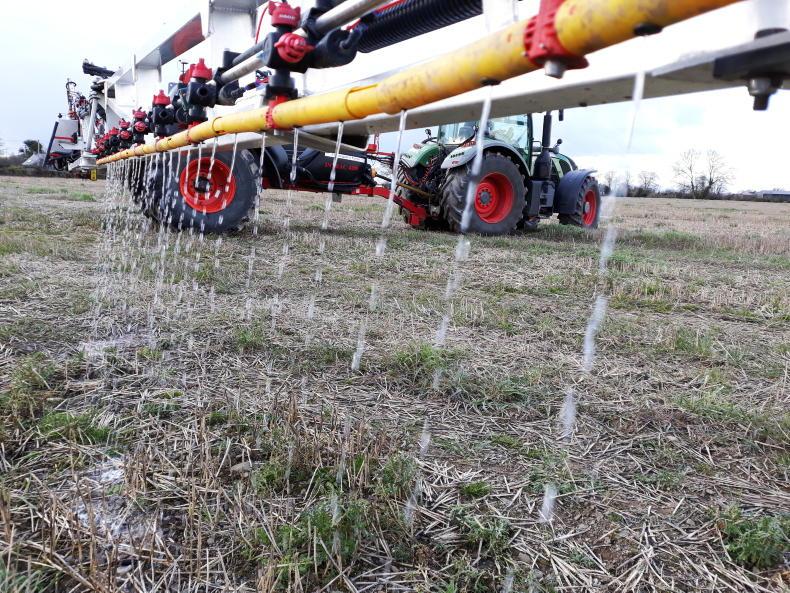Liquid nitrogen (N) has seen a resurgence in popularity recently. At the Teagasc malting barley conference, Richie Hackett busted some of the myths around its use and gave solid advice for those considering a change.
The first thing made very clear was that “it’s not a foliar fertiliser, it’s a soil-acting fertiliser”.
Richie explained that the objective is to get N into the soil so that the plants can get it from the soil.
As a result, it needs to be applied in large droplets that will bounce off the leaf, so a change of nozzle or a move to streamers is needed on a sprayer.
Liquid N is a mixture of urea, ammonium nitrate and nitrate, so it is subject to losses, but can also contain a urease inhibitor to protect the urea N. Some forms may contain sulphur and trace elements, and products can vary in stability. Looking at losses, liquid N falls in between urea and CAN (CAN having lower losses). The addition of NBPT to protect urea brings losses closer to those of CAN. A similar trend is followed for crop yield and crop nitrogen uptake, with CAN being most efficient, followed by liquid N. The biggest advantage in its use is the accuracy of spread, but Richie cautioned that if tramline widths are not correct, an overlap can cause lodging.
Evenness of application, particularly on wide tramlines or in windy conditions.Potential to have fewer overlaps on ins and outs if tramline widths are accurate.Depending on storage, there may be a slight ‘kg of N’ cost advantage.Disadvantages of liquid N
50% of the N is urea and can be lost as ammonia, but an inhibitor can be used to protect the urea.Crop scorch can be an issue.Storage may be needed on-farm, if a source is not available nearby.Corrosion – need very good machinery hygiene.Don Summers from Co Wexford shared his experience, noting that he farms near a merchant who has liquid N on site and so applies when it suits conditions.
He did not have to invest in a tank, just the correct nozzles for the sprayer.
He uses section control on his sprayer, so can avoid overlaps. It also allows him to spread accurately on a windy day and avoid placement of fertiliser into hedgerows.
Liquid nitrogen (N) has seen a resurgence in popularity recently. At the Teagasc malting barley conference, Richie Hackett busted some of the myths around its use and gave solid advice for those considering a change.
The first thing made very clear was that “it’s not a foliar fertiliser, it’s a soil-acting fertiliser”.
Richie explained that the objective is to get N into the soil so that the plants can get it from the soil.
As a result, it needs to be applied in large droplets that will bounce off the leaf, so a change of nozzle or a move to streamers is needed on a sprayer.
Liquid N is a mixture of urea, ammonium nitrate and nitrate, so it is subject to losses, but can also contain a urease inhibitor to protect the urea N. Some forms may contain sulphur and trace elements, and products can vary in stability. Looking at losses, liquid N falls in between urea and CAN (CAN having lower losses). The addition of NBPT to protect urea brings losses closer to those of CAN. A similar trend is followed for crop yield and crop nitrogen uptake, with CAN being most efficient, followed by liquid N. The biggest advantage in its use is the accuracy of spread, but Richie cautioned that if tramline widths are not correct, an overlap can cause lodging.
Evenness of application, particularly on wide tramlines or in windy conditions.Potential to have fewer overlaps on ins and outs if tramline widths are accurate.Depending on storage, there may be a slight ‘kg of N’ cost advantage.Disadvantages of liquid N
50% of the N is urea and can be lost as ammonia, but an inhibitor can be used to protect the urea.Crop scorch can be an issue.Storage may be needed on-farm, if a source is not available nearby.Corrosion – need very good machinery hygiene.Don Summers from Co Wexford shared his experience, noting that he farms near a merchant who has liquid N on site and so applies when it suits conditions.
He did not have to invest in a tank, just the correct nozzles for the sprayer.
He uses section control on his sprayer, so can avoid overlaps. It also allows him to spread accurately on a windy day and avoid placement of fertiliser into hedgerows.






 This is a subscriber-only article
This is a subscriber-only article











SHARING OPTIONS: